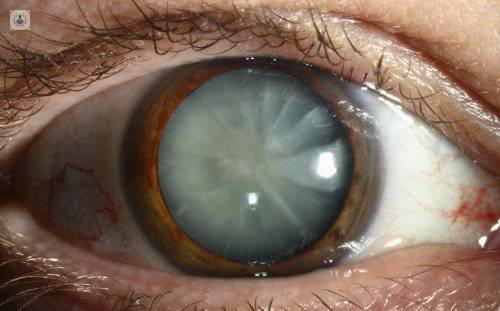Catarata, enfermedad que viene con la edad
Hay distintos tipos de catarata pero la más común es la senil, la cual generalmente comienza a darse entre los 50 y 60 años. El único tratamiento que existe es el quirúrgico, el cual gracias a los avances tecnológicos es poco riesgoso
Dr. Carlos Romo Arpio
 El motivo más frecuente de catarata es la catarata senil, que es secundario a la edad. Con la edad el cristalino, que es el lente interno que tiene el ojo, comienza a cambiar. Los primeros signos de esos cambios se experimentan como a los 40-50 años, cuando se pierde el poder de enfocar. Este lente normalmente es blando y tiene la capacidad de cambiar su forma para enfocar. Más tarde, después de endurecerse y perder ese poder de enfocar, se empieza a opacar formándose lo que se conoce como catarata.
El motivo más frecuente de catarata es la catarata senil, que es secundario a la edad. Con la edad el cristalino, que es el lente interno que tiene el ojo, comienza a cambiar. Los primeros signos de esos cambios se experimentan como a los 40-50 años, cuando se pierde el poder de enfocar. Este lente normalmente es blando y tiene la capacidad de cambiar su forma para enfocar. Más tarde, después de endurecerse y perder ese poder de enfocar, se empieza a opacar formándose lo que se conoce como catarata.
También hay cataratas secundarias por medicamentos, secundarias a cambios metabólicos como la diabetes y también existen cataratas congénitas, pero las cataratas más frecuentes son las relacionadas con la edad.
Retrasar la evolución de la catarata
Se ha encontrado que una buena alimentación e inclusive suplementos alimenticios ayudan a retrasar la evolución de la catarata. Lógicamente la exposición a ciertos medicamentos, como los esteroides, pueden acelerar este proceso. Pero no es posible detenerlo actualmente. La catarata afecta por igual a hombres y a mujeres.
El lente intraocular
El único tratamiento que existe actualmente es el quirúrgico. La extracción de catarata se basa en retirar el cristalino manteniendo su cubierta, que es la cápsula, para que en este lugar se introduzca una lente intraocular.
La lente intraocular va orientada a las necesidades del paciente, por ejemplo, si el paciente quiere mantener vision lejana, intermedia y cercana hay lentes multifocales que les pueden dar los tres rangos de visión. Si el paciente tiene astigmatismo existen lentes tóricos, que ayudan a corregirlo. Y si el paciente sólo requiere visión lejana/intermedia o cercana se puede poner un lente monofocal que da una excelente calidad óptica.
Tratamiento combinado
La técnica más moderna para retirar la catarata es hacerlo con una cuestión combinada, esto es con láser de femtosegundo, que ayuda a hacer las incisiones , la capsulorrexis, que es la entrada a la bolsa y ayuda a dividir la catarata y después retirarla con facoemulsificasión, que es una especie de ultrasonido que destruye la dureza de la catarata y la absorbe.
La vista se restablece del todo si el paciente no tiene ninguna otra alteración ocular agregada y se recupera al 100%.
La recuperación es casi inmediata. Cuando un paciente se opera de catarata se utiliza anestesia tópica y prácticamente sale viendo casi a la perfeccion, a veces cuando las cataratas son más duras y se necesita de más poder para destruirla se tienden a inflamar un poco. Se recomienda reposo de 1 a 2 semanas dependiendo el caso, pero las incisiones de hoy en día son tan pequeñas que ya ni siquiera se necesitan puntos, el riesgo es muy bajo.